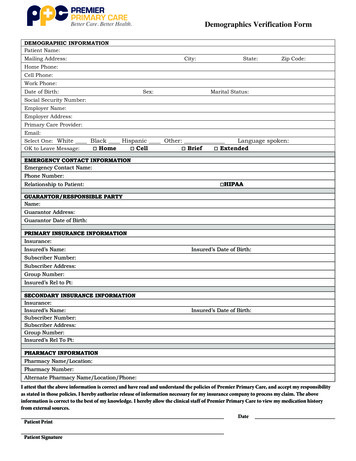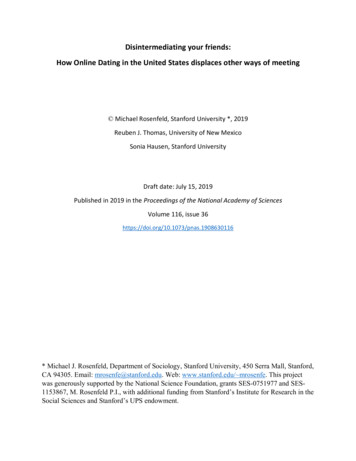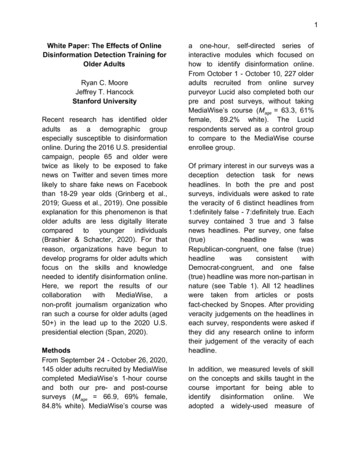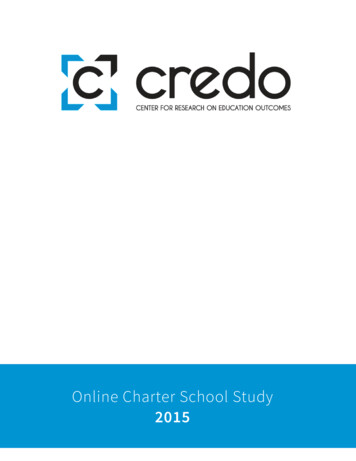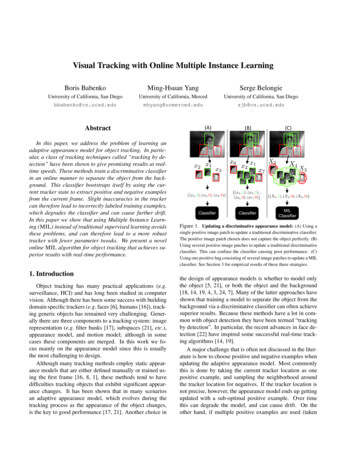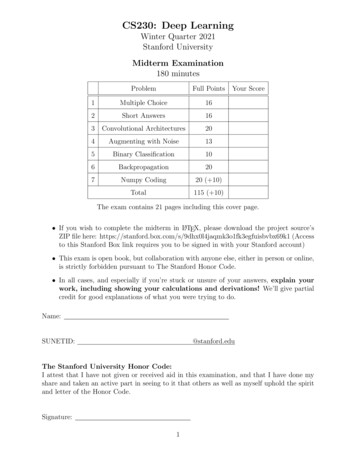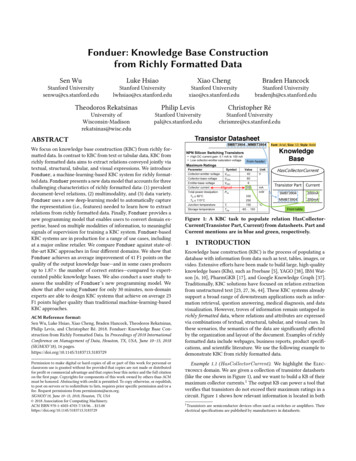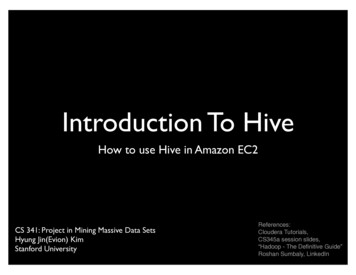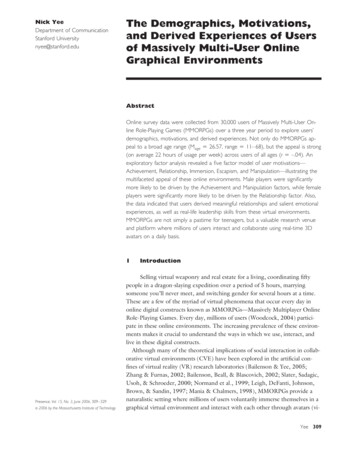
Transcription
Nick YeeDepartment of CommunicationStanford Universitynyee@stanford.eduThe Demographics, Motivations,and Derived Experiences of Usersof Massively Multi-User OnlineGraphical EnvironmentsAbstractOnline survey data were collected from 30,000 users of Massively Multi-User Online Role-Playing Games (MMORPGs) over a three year period to explore users’demographics, motivations, and derived experiences. Not only do MMORPGs appeal to a broad age range (Mage 26.57, range 11– 68), but the appeal is strong(on average 22 hours of usage per week) across users of all ages (r –.04). Anexploratory factor analysis revealed a five factor model of user motivations—Achievement, Relationship, Immersion, Escapism, and Manipulation—illustrating themultifaceted appeal of these online environments. Male players were significantlymore likely to be driven by the Achievement and Manipulation factors, while femaleplayers were significantly more likely to be driven by the Relationship factor. Also,the data indicated that users derived meaningful relationships and salient emotionalexperiences, as well as real-life leadership skills from these virtual environments.MMORPGs are not simply a pastime for teenagers, but a valuable research venueand platform where millions of users interact and collaborate using real-time 3Davatars on a daily basis.1Presence, Vol. 15, No. 3, June 2006, 309 –329 2006 by the Massachusetts Institute of TechnologyIntroductionSelling virtual weaponry and real estate for a living, coordinating fiftypeople in a dragon-slaying expedition over a period of 5 hours, marryingsomeone you’ll never meet, and switching gender for several hours at a time.These are a few of the myriad of virtual phenomena that occur every day inonline digital constructs known as MMORPGs—Massively Multiplayer OnlineRole-Playing Games. Every day, millions of users (Woodcock, 2004) participate in these online environments. The increasing prevalence of these environments makes it crucial to understand the ways in which we use, interact, andlive in these digital constructs.Although many of the theoretical implications of social interaction in collaborative virtual environments (CVE) have been explored in the artificial confines of virtual reality (VR) research laboratories (Bailenson & Yee, 2005;Zhang & Furnas, 2002; Bailenson, Beall, & Blascovich, 2002; Slater, Sadagic,Usoh, & Schroeder, 2000; Normand et al., 1999; Leigh, DeFanti, Johnson,Brown, & Sandin, 1997; Mania & Chalmers, 1998), MMORPGs provide anaturalistic setting where millions of users voluntarily immerse themselves in agraphical virtual environment and interact with each other through avatars (viYee 309
310 PRESENCE: VOLUME 15, NUMBER 3Table 1. Attributes of Three Gaming ParadigmsAttributeStand-alone gamesLocal and wide areanetwork gamesExemplarsCost for playerNo. of players in worldPersistent worldMode of user agencySize/scope of worldSolitaire, Snood,SimCity, RiskSoftware1NoDirect/godlike controlAbstracted game boardDiablo II, Unreal, Age ofEmpiresSoftware1–16NoOne or several avatarsAbstracted or limited worldsPlayer social interactionNoneCombat strategy drivensual representations of users in a digital environment)on a daily basis. The opportunity to study what peopleactually do when they choose to be in a virtual environment with thousands of other people cannot be overstated, and that is the underlying rationale for the current studies.Existing research on computer or video gaming tendsto focus on two main areas: the negative effects of playing video games and whether video games can be usedfor pedagogical purposes. For example, an extensive lineof research has focused on demonstrating that violentvideo games increase real-life aggression (Ballard &Lineberger, 1999; Anderson & Dill, 2000; Anderson &Bushman, 2001), and survey studies have shown positive correlations between preference for video gamesand aggressiveness (Scott, 1995; Funk et al., 2002),delinquency (Anderson & Dill, 2000), and lower perceived self-concept (Funk, Buchman & Germann,2000); however, the generalizability of short-term measures of aggression in experimental studies and the inability to infer causality in survey studies is a concern inthis line of research (Griffiths, 1999). One notable exception is a longitudinal experimental study conductedby Williams and Skoric (2005). The findings of thisstudy did not support the assertion that playing a violent video game will cause substantial increases in realworld aggression.MMORPGsEverQuest, Star WarsGalaxiesSoftware subscription0–2000YesPersonal avatarNaturalistic worlds/galaxies,not abstractedRich, collaborative, socialinteractionsAnother line of research has explored the pedagogicaluses of video games among elementary school students(Ko, 2002), high-school students (Ravenscroft &Matheson, 2002), and college students (Moreno &Mayer, 2002). Video games can also enhance sensorimotor tasks (Fery & Ponserre, 2001), visual acuity andattention (Green & Bavelier, 2003), as well as aid in therecovery of motor skills after physical trauma (Taylor &Berry, 1998). In fact, some have explicitly argued thatvideo games should be considered as platforms forlearning (Gee, 2003).1.1 What are MMORPGs?Both lines of above research have mostly relied onsingle-player games, but as the ubiquity of high-speedinternet connections and powerful computer processorshave increased with a steady decrease in cost, the paradigm of computer gaming has changed dramatically,and MMORPGs are the vanguard of a new generationof computer games that takes advantage of the accessibility of the internet and the graphical processing capability of standard computer systems.MMORPGs are a new paradigm in computer gaming(see Table 1). By definition, MMORPG users are partof a persistent world of up to 2000 other concurrentusers (Sony Online, 2003). A persistent world is a world
Yeethat exists independent of the users. In stand-alonegames and local network games, the world only existswhen the game is started by the user, and thus is dependent on the user “activating” it. In an MMORPG, theworld exists before the user logs on, and continues toexist when the user logs off. More importantly, eventsand interactions occur in the world (driven by otherusers) even when the user is not logged on to the persistent world. To accommodate the sheer number of users,the worlds in MMORPGs are vast and varied (in termsof terrain, flora, fauna, and local inhabitants). In contrast, the worlds of most stand-alone and local networkgames are simplistic and can only accommodate fewerthan 16 concurrent players in a space that can be traversed in a few minutes.On a simplistic level, MMORPGs could be thoughtof as a scenic chat room with a variety of interactivetasks. Users experience cities, jungles, and even the falling rain or snow in rich real-time 3D graphics, andcommunicate with each other using typed chat andtemplated gestures and expressions. They interact withthe world through a combination of mouse-driven interfaces and typed commands, and partake of a largenumber of varied activities that increase in complexity,reward, and time involvement which typically operateon a random-ratio reinforcement schedule. These activities revolve around character advancement and translateinto a functional advantage in terms of the mechanics ofthe world, whether this is combat capability, social status, avatar appearance, geographic knowledge, equipment quality, or even cooking skills. Whereas the firstfew MMORPGs focused heavily on combat-orientedadvancement, recent MMORPGs have offered morediverse forms of advancement. For example, in StarWars Galaxies, one can become a skilled musician, chef,hair stylist, animal tamer, or politician.Most forms of advancement in MMORPGs requireincreasing cooperation or dependency on other users,oftentimes mutually beneficial. In Star Wars Galaxies,scouts hunt and harvest hides and meat from animalswhich they can sell to artisans who need those resourcesto craft basic items. Most combat professions need thecomplementary support of each other as they tackle311more and more difficult creatures or enemies that inturn hold larger rewards. But ultimately, each user decides which form of advancement they will pursue, andthe richness and complexity of the environment eliminates the need for super-ordinate goals or storylines.Every user is motivated by a different combination ofthe possible rewards. The result is that adventures, stories, and most importantly for the purpose of the current work, meaningful relationships between usersemerge during interaction. Functional constructs withinthe environment facilitate these social networks— combat groups (temporary collaboration between a few users), guilds (persistent user-created membership organizations), and ideological alliances (agreements betweenguilds or “racial” groups).Given how different MMORPGs are from standalone and local network games, perhaps a better comparison is with live-action or table-top role-playinggames (RPGs) or multi-user domains (MUDs)—thetextual predecessors of MMORPGs. MMORPGs aredifferent from RPGs in one important aspect. While theworld of an MMORPG is persistent and exists independent of players, the world of an RPG exists only whenthe players have convened in a physical location. Also,this physical constraint means that it is not possible toconvincingly change one’s representation in an RPG theway it is possible in an MMORPG— especially in termsof gender and race. Furthermore, the physical constraints of RPGs make it more likely that RPG playersknow each other when compared with MMORPG players. MMORPGs are in fact much more similar toMUDs than other genres of video games in that bothhave persistent game worlds where players can interactusing avatars.Currently, there is very little quantitative research onMMORPGs or MUDs. While researchers like Turkle(1995), Bruckman (1993), and Bruckman and Resnick(1995) have contributed a great deal to our understanding of the users of MUDs, their approaches were morequalitative and relied on anecdotal stories, interviewdata, or personal experience. For example, Turkle illustrated how digital self-representation in MUDs allowedusers to understand the fluid, dynamic, and postmodern
312 PRESENCE: VOLUME 15, NUMBER 3nature of their identities. Almost no quantitative studiesof MUDs exist. One of the few quantitative studies ofMUDs explored how sociability and skepticism towardcomputer-mediated communication influenced socialbehavior within MUDs (Utz, 2000). Also worth notingis a multi-methods study of LambdaMOO by Schianoand White (1998) that illustrated, among other things,that LambdaMOO users preferred stable, integratedidentities as opposed to the fluid, fragmented identitiesTurkle suggested. Existing research on MMORPGs hasmostly relied on analysis of publicly available data. Forexample, Castronova (2002) has used the eBay salestransactions of virtual items to show that the economyof EverQuest is quantifiable and has a higher gross domestic product than some developing countries, and toshow the inequity between the value of the virtual maleand female body (Castronova, 2003). Griffiths, Davies,and Chappell (2003) aggregated online poll data atwebsites catering to EverQuest players to provide thebasic demographics and preferences of EverQuest players. Very few studies have used primary sources of data.One of the few is a study by Axelsson and Regan (2002)that explored the impact of group affiliation on socialbehavior in the MMORPG Asheron’s Call. The studyfound that group affiliation makes people more socialboth online and offline.Over the course of three years, I have collected onlinesurvey data from 30,000 MMORPG players. Preliminary qualitative data from open-ended questions wereused to form theoretical questions about the motivations and relationship formation of MMORPG users,among other issues (Yee, 2006). In that previous paper,I argued that the architecture of these environmentsfacilitates relationship formation, and they are windowsinto and catalysts in existing relationships in the materialworld. The goal of the current work was to complementthese previous findings by providing a more rigorousquantitative analysis on who uses MMORPGs, whatmotivates their use, and the salience and impact of theexperiences that emerge in these environments. Moreover, this paper attempts to articulate the many opportunities to study social identity, social interaction, andrelationship formation in these environments.1.2 Demographics and UsageThe apparent focus of existing video game research on adolescent users creates the illusion that videogame players are a youth subculture, and that videogames are a teenage pastime of no important consequence apart from their ability to increase real-life aggression. For example, the entire volume of a recentspecial issue of the Journal of Adolescence (Vol. 21-1)was devoted to the negative effects of video games onadolescent gamers. The following quotes from that issueillustrate the assumption that adolescents are the primary consumers of video games or that video gamessomehow impact adults in an entirely different way thatisn’t worth mentioning or studying.Video games have become one of the favorite activities of American children. (p.5)The rise and popularity of video and computergames as a leisure phenomenon has become an everincreasing part of many young people’s day-to-daylives. (p.1)A lot of youths are playing violent video games formany hours per week. When large numbers of youths(including young adults) are exposed to many hoursof media violence (including violent video games),even a small effect can have extremely large societalconsequences. (p.120)In spite of the fact that the average age of computer and video game players is 30 (Entertainment Software Association, 2005), the articles in the special issueseem to perpetuate the assumption that mainly childrenand adolescents play vid
online digital constructs known as MMORPGs—Massively Multiplayer Online Role-Playing Games. Every day, millions of users (Woodcock, 2004) partici-pate in these online environments. The increasing prevalence of these environ-ments makes it crucial to understand the ways in which we use, interact, and live in these digital constructs.
